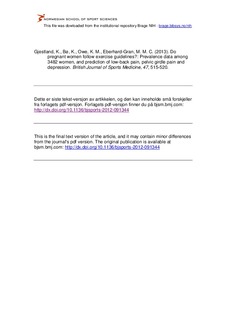| dc.contributor.author | Gjestland, Kristin | |
| dc.contributor.author | Bø, Kari | |
| dc.contributor.author | Owe, Katrine M. | |
| dc.contributor.author | Eberhard-Gran, Malin | |
| dc.date.accessioned | 2013-05-10T07:43:58Z | |
| dc.date.available | 2013-05-10T07:43:58Z | |
| dc.date.issued | 2013-08-17 | |
| dc.identifier | Seksjon for idrettsmedisinske fag / Department of Sports Medicine | |
| dc.identifier.citation | British Journal of Sports Medicine. 2013, 47, 515-520 | no_NO |
| dc.identifier.issn | 1473-0480 | |
| dc.identifier.uri | http://hdl.handle.net/11250/171108 | |
| dc.description | I Brage finner du siste tekst-versjon av artikkelen, og den kan inneholde ubetydelige forskjeller fra forlagets pdf-versjon. Forlagets pdf-versjon finner du på bjsm.bmj.com: http://dx.doi.org/10.1136/bjsports-2012-091344 / In Brage you'll find the final text version of the article, and it may contain insignificant differences from the journal's pdf version. The definitive version is available at bjsm.bmj.com: http://dx.doi.org/10.1136/bjsports-2012-091344 | no_NO |
| dc.description.abstract | Purpose: We describe exercise level in mid-pregnancy, associated sociodemographic variables, and investigate the association between exercise in mid-pregnancy and subsequent low-back pain, pelvic girdle pain and depression at 32 weeks of pregnancy.
Material and methods: The study included 3482 pregnant women participating in the Akershus Birth Cohort study (response rate 80.5%). Data were collected by a questionnaire in pregnancy weeks 17–21, pregnancy week 32 and electronic birth journal. The results were analysed by logistic regression and are presented as crude (cOR) and adjusted OR (aOR) with 95% CI.
Results: Only 14.6% of the respondents followed the current exercise prescription for exercise during pregnancy (≥3 times a week, >20 min at moderate intensity). One-third of the study sample exercised less than once a week at pregnancy weeks 17–21. Women exercising either 1–2 times or ≥3 times a week at mid-pregnancy were more often primiparous, higher-educated and had less often prepregnacy body mass index >30 kg/m2 compared with women exercising less than once a week. Women who exercised ≥3 times a week were less likely to report pelvic girdle pain (aOR: 0.76, 95% CI 0.61 to 0.96), while women exercising 1–2 times a week were less likely to report low-back pain (aOR: 0.80, 95% CI 0.66 to 0.97) and depression (aOR: 0.66, 95% CI 0.48 to 0.91).
Conclusions: Few Norwegian women follow current exercise prescriptions for exercise in mid-pregnancy. The results may indicate an association between exercising mid-pregnancy and lower prevalence of low-back pain, pelvic girdle pain and depression in late pregnancy. | no_NO |
| dc.language.iso | eng | no_NO |
| dc.publisher | BJM Group | no_NO |
| dc.subject | adult | |
| dc.subject | body mass index | |
| dc.subject | cohort studies | |
| dc.subject | depression / prevention & control | |
| dc.subject | educational status | |
| dc.subject | exercise therapy | |
| dc.subject | female | |
| dc.subject | low back pain | |
| dc.subject | parity | |
| dc.subject | patient compliance | |
| dc.subject | pelvic girdle pain / prevention & control | |
| dc.subject | pregnancy | |
| dc.subject | pregnancy complications / prevention & control | |
| dc.subject | pregnancy trimester, second | |
| dc.title | Do pregnant women follow exercise guidelines?: Prevalence data among 3482 women, and prediction of low-back pain, pelvic girdle pain and depression | no_NO |
| dc.type | Journal article | no_NO |
| dc.type | Peer reviewed | no_NO |
| dc.subject.nsi | VDP::Social science: 200::Social science in sports: 330::Other subjects within physical education: 339 | no_NO |
| dc.source.journal | British Journal of Sports Medicine | |
| dc.identifier.doi | 10.1136/bjsports-2012-091344 | |
